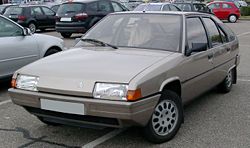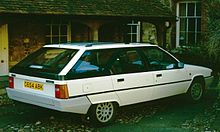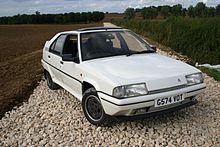- Citroën BX
-
Citroën BX 
Manufacturer Citroën Production 1982—1994 Assembly Rennes, France Predecessor Citroën GS Successor Citroën Xantia Class Large family car Body style 5-door hatchback
5-door estateLayout Front-engine, front-wheel drive / four-wheel drive Engine 1.1 L I4
1.4 L I4
1.6 L I4
1.8 L turbodiesel I4
1.9 L I4
1.9 L I4 16-valve
1.9 L diesel I4Kerb weight 960 kg (2,116 lb) - 1,220 kg (2,690 lb) Related Peugeot 405 Designer Marcello Gandini The Citroën BX is a large family car that was produced by the French manufacturer Citroën from 1982 to 1994. In total, 2,315,739 BXs were built during its 12-year history.[1] The hatchback was discontinued in 1993 with the arrival of the Xantia, but the estate continued for another year.
Contents
History
The Citroën BX was launched in Paris on 2 October 1982[2] under the Eiffel Tower. The BX was designed to replace the successful small family car Citroën GS/A with a larger vehicle. The French advertising campaign used the slogan "J'aime, j'aime, j'aime" showing the car accompanied by music written specially by Julien Clerc.
The angular Marcello Gandini-designed hatchback was strongly inspired by the British 1977 Reliant FW11 concept and the 1979 Volvo Tundra concept car (also designed by Bertone). It was one of the first cars to benefit from the merger of Peugeot and Citroën in 1976, sharing its platform with the more conventional 405 that appeared in 1987. Among the features that set the car apart from the competition was the traditional Citroën hydropneumatic self-levelling suspension, extensive use of plastic body panels (bonnet, tailgate, bumpers), and front and rear disc brakes.
The BX dispensed of the air cooled, flat four engine which powered the GS, and replaced it with the new PSA group XY, TU and XU series of petrol engines in 1.4 L, 1.6 L and 1.9 L displacements (a 1.1 L engine, very unusual in a car of this size, was also available in Italy, Portugal and Greece). The 1.1 and 1.4 unit was an old Peugeot/Renault powertrain with its roots in the Peugeot 104 and Renault 14, but the 1.6 and 1.9 was all-new and later used in many Peugeots. The class leading[citation needed] XUD diesel engine version was launched in 1984. The diesel and turbo diesel models were to become the most successful variants, they were especially popular as estates and became the best selling diesel car in Britain.
All petrol engines were badged as 11, 14, 16, 19 — signifying engine size (In some countries, a weaker, 80 PS (59 kW) version of the 1.6 L engine was badged as the BX15E instead of BX16). The 11TE model was seen by foreign motoring press as slow and uncomfortable.[citation needed]
The 1.1 L engine with engine code H1A was specially tuned for Italy, Greece and Portugal. It was fitted to the cars made from 1988 to 1993 and produced 40 kW (55 hp DIN) at 5800 rpm.
A year after the launch of the hatchback model, an estate version was made available. In the late 1980s, a four-wheel drive system and turbodiesel engines were introduced.
All BXs are known for an exceptionally smooth ride, reasonable fuel economy and potent brakes. The perceived complexity of the suspension system meant that changing of the hydraulic oil (LHM) was often neglected, leading to otherwise avoidable repairs. Maintenance was seen as expensive because the suspension spheres (the equivalent of the spring and shock absorber on conventionally sprung cars) needed to be replaced every three to four years, however on the BX they were easy to change and a cheap consumable, which could even be re-gassed for a fraction of the cost. On MK2 models, the suspension piping was better protected against corrosion, and less prone to failure. That is why there are very few original Mark 1 BXs on the road today. Rust protection of the bodywork was much better than earlier Citroëns and also better than average.
Famous owners of the BX include Italian automobile designer Marcello Gandini, who penned both the BX and the Lamborghini Countach. Citroën featured Marcello Gandini in its advertising campaigns in the early 1990s.
The amount of standard and optional equipment available to BX customers was also surprisingly high for a car of its size and class. Besides the superior hydropneumatic suspension, one could also have equipment such as anti-lock brakes, air conditioning, electric windows and mirrors, power sunroof, a remote-controlled central locking system and leather upholstery.
In 1986 the MK2 BX was launched. The interior and dashboard was redesigned to be more conventional-looking than the original, which used Citroën's idiosyncratic "satellite" switchgear, and "bathroom scale" speedometer. These were replaced with more conventional stalks for light and wipers and analogue instruments. The earlier GT models already had a "normal" speedometer and tachometer. The exterior was also slightly updated, with new more rounded bumpers, flared wheelarches to accept wider tyres, new and improved mirrors and the front indicators replaced with larger clear ones which fitted flush with the headlights.
1988 saw the launch of the BX Turbo Diesel, which was very highly praised by the motoring press. The BX diesel was already a strong seller, but the Turbo model brought new levels of refinement and performance to the diesel market, which brought an end to the common notion that diesel cars were slow and noisy. Diesel Car magazine said of the BX "We can think of no other car currently on sale in the UK that comes anywhere near approaching the BX Turbo's combination of performance, accommodation and economy".[3]
In 1989, the BX range had further minor revisions and specification improvements made to it, including smoked rear lamp units, new wheeltrims and interior fabrics.
Winning many Towcar of the Year awards, the BX was very well renowned as a tow car (as was its larger sister, the CX), especially the diesel models, due to their power and economy combined with the self levelling suspension. The BX was the most highly acclaimed towcar worldwide.[4]
The biggest problem of the BX was its variable build quality, compared to its competition. It dramatically improved over its life, until with the launch of its replacement the Citroën Xantia build quality was being compared favourably with German cars. The last BX was made in 1994, by which time its successors had already been launched. It had been partially replaced by the smaller ZX in early 1991, but its key replacement was the slightly larger Xantia that went on sale on March 1993.
Performance models
16V
In May 1987, a 16-valve version of the GTi was launched. This was the first French production car to be fitted with a 16-valve engine. A DOHC naturally aspirated 1.9 L engine, producing 160 bhp (120 kW) and 177 N·m (131 lb·ft) of torque, rocketed the BX to 100 km/h (62 mph) in 7.4 seconds, stopping at a top speed of 220 km/h (140 mph). Anti-lock brakes were fitted as standard. Its side skirts made it easily recognizable from all other BX models. In 1990, the facelift of the 16V gave the car a new lease of life. The updated car came with new fibreglass bumpers, anthracite painted wheels, smoked taillight lenses, and a redesigned rear spoiler. These cosmetic changes made the car look even more distinctive from other BXs. There were also a few subtle changes made to the car's performance, the most noticeable being harder suspension and a thicker anti-roll bar, which improved handling. BX 16V was found to be faster around a race-track than the "in house" competitor Peugeot 405 Mi16 in a test in the Swedish motormagazine Teknikens Värld.
Even in competition the 16V was successful. Jean-Luc Pallier drove a 240 bhp (180 kW) BX 16V, in strong competition with for example Renault 21 Turbo, Opel Kadett GSI, BMW M3 and Ford Sierra RS Cosworth. He was left in the start but later he passed the competitors mainly on the inside in the bends with the rear inner wheel in the air. It was possible because of the front wheel drive and the excellent handling of his 16V.
In rallying, young Swedish driver Magnus Gustafsson successfully drove a BX 16V supported by the Swedish Citroën dealers. It was tuned by Swedish firm Custom Racing to over 200 bhp (150 kW) and had a six speed gearbox from Peugeot Talbot Sport. The car also had a hydractive suspension unit from a Citroën XM installed. Gustafsson won a lot of smaller national events, but his best result was a second position in the 2 L category in the Swedish International Rally 1992 and a victory in South Swedish Rally (also in the 2 L category, of course). BX 16V (and also BX 8V) is still seen in rallying in Sweden in national categories.
Sport
As well as the normal BX, Citroën produced the BX Sport from 1985 to 1987. During this period, Citroën produced 7,500 BX Sports; 2,500 at first, then an extra 5,000 due to its sales success. Rated at 126 bhp (94 kW) and equipped with dual 2-barrel carburettors, the BX Sport was the most powerful BX in production at that time. It also stood out with its unique body kit, alloy wheels used on the GTi later in the BX's life, a unique dashboard and PULLMAN interior. The car was only available in left hand drive and so it was not sold in the UK.
GT
The BX GT was launched in 1985 and featured a 1.9 L Peugeot-sourced engine, in general, a Sport engine with only one twin choke carburettor. That same year, Citroën produced a "Digit" model, which was based on the BX GT. It featured a digital instrument cluster and an onboard computer. Citroën only produced 4000 Digits in 1985.[5]
GTi
An uprated version of the BX GT, the BX19 GTi was fitted with an 1.9 L 8-valve fuel injected engine producing 122 PS (90 kW) (also fitted to the 205 GTi), a spoiler and firmer suspension spheres/anti-roll bar than the standard model; it could reach 198 km/h.[6] There was also a special export model, the BX16 GTi, using the 113 PS (83 kW) XU5JA engine from the Peugeot 205 GTi 1.6. Top speed was 194 km/h.[7]
4TC
Citroën entered Group B rallying with the BX in 1986. The specially designed rally BX was called the BX 4TC and bore little resemblance to the standard BX. It had a very long nose because the engine (a turbocharger fitted version of Chrysler Europe's Simca Type 180 engine) was mounted longitudinally unlike in the regular BX. The rally version of the BX also featured the unique hydropneumatic suspension. Because of the Group B regulations, 200 street versions of the 4TC also had to be built.
The 4TC was never very successful in World Rally Championship competition, its best result being 6th place in the 1986 Swedish Rally, and Citroën only participated in three Group B rallies before the Group B class was banned in late 1986, following the death of Henri Toivonen in his Lancia Delta S4 at the Tour de Corse Rally. Citroën was ashamed of the performance of its cars, and immediately recalled and scrapped as many examples as it could, making the BX 4TC road and race cars extremely rare and sought-after.
See also
References
- ^ "Dates" (Paris: Automobiles Citroën Corporate Communications Division, 1999), p.76.
- ^ "Citroen Bx ()". Histomobile.com. 1982-10-02. http://www.histomobile.com/dvd_histomobile/usa/10/1982_Citroen_Bx.htm. Retrieved 2011-08-07.
- ^ "Diesel Car" (Future Publishing Limited, August/September edition, 1998), p.22
- ^ "Diesel Car" (Future Publishing Limited, August/September edition, 1998), p.96
- ^ "Dates" (Paris: Automobiles Citroën Corporate Communications Division, 1999), p.78.
- ^ Mastrostefano, Raffaele, ed (1990) (in Italian). Quattroruote: Tutte le Auto del Mondo 1990. Milano: Editoriale Domus S.p.A. pp. 144–145.
- ^ Tutte le Auto del Mondo 1990, p. 143
External links
- Citroën BX 16-valve Club
- BX links Citroën World
- web based UK BX owners club
- http://www.citroencarclub.org.uk
« previous — Automobiles Citroën, a subsidiary of the PSA Peugeot Citroën since 1976, car timeline, 1980s–present Type 1980s 1990s 2000s 2010s 0 1 2 3 4 5 6 7 8 9 0 1 2 3 4 5 6 7 8 9 0 1 2 3 4 5 6 7 8 9 0 1 Economy car 2CV Off-roader Méhari City car C1 Supermini LN / LNA AX Dyane Axel Saxo I Saxo II C2 DS3 Visa C3 I C3 II Small family car GSA ZX Xsara I Xsara II C4 I C4 II DS4 Large family car BX Xantia C5 I C5 II DS5 Executive car CX XM C6 Leisure
activity vehicleAcadiane C15 Nemo Berlingo Berlingo II Compact
MPVXsara Picasso C3 Picasso C4 Picasso Large MPV Evasion/Synergie C8 C4 Grand Picasso Crossover C-Crosser Convertible C3 Pluriel Van H Van C25 Jumpy I Jumpy II C35 Jumper Jumper II Categories:- Citroën vehicles
- Mid-size cars
- Front wheel drive vehicles
- All wheel drive vehicles
- Hatchbacks
- Station wagons
- 1980s automobiles
- 1990s automobiles
- Vehicles introduced in 1982
- Group B cars
Wikimedia Foundation. 2010.



